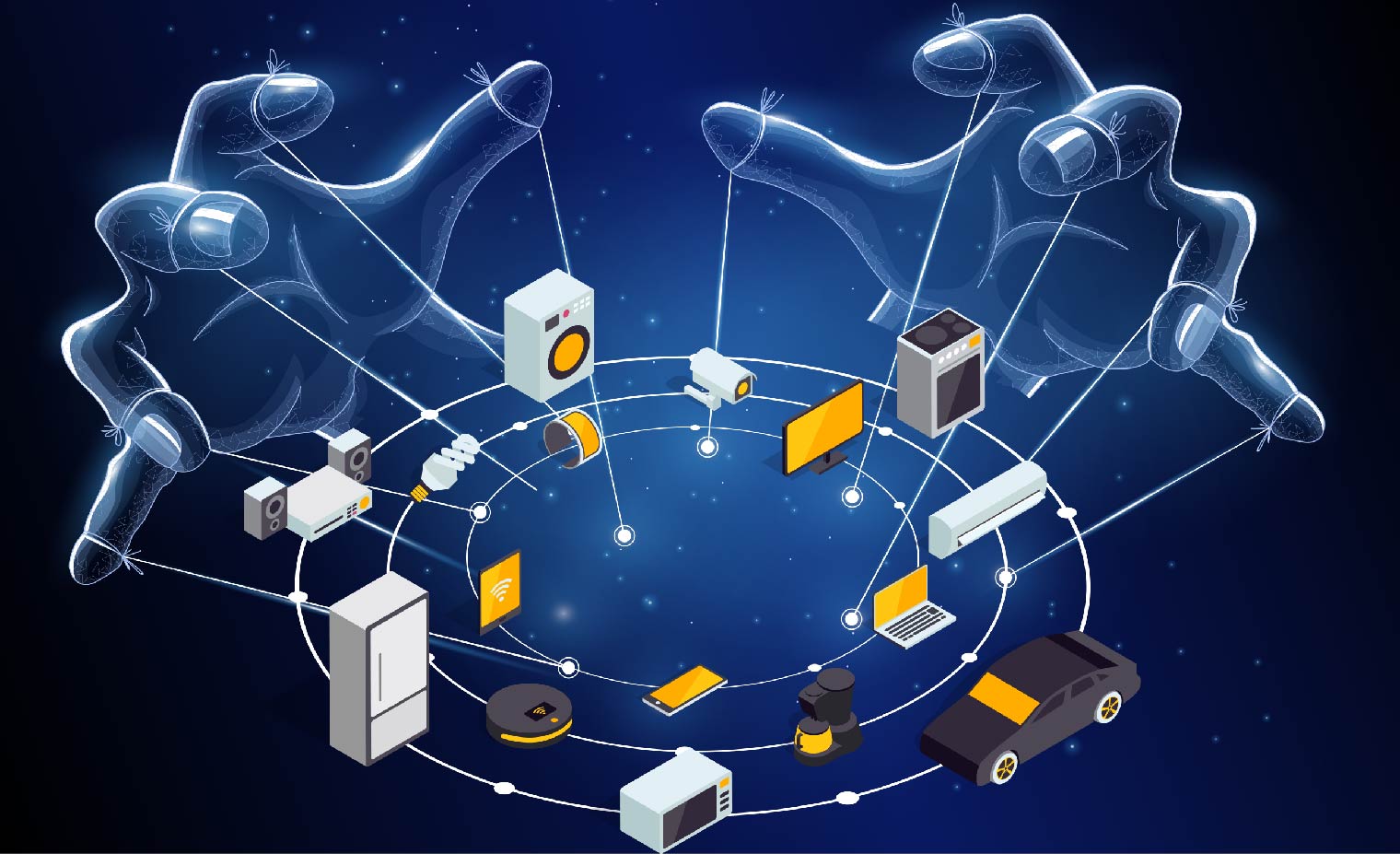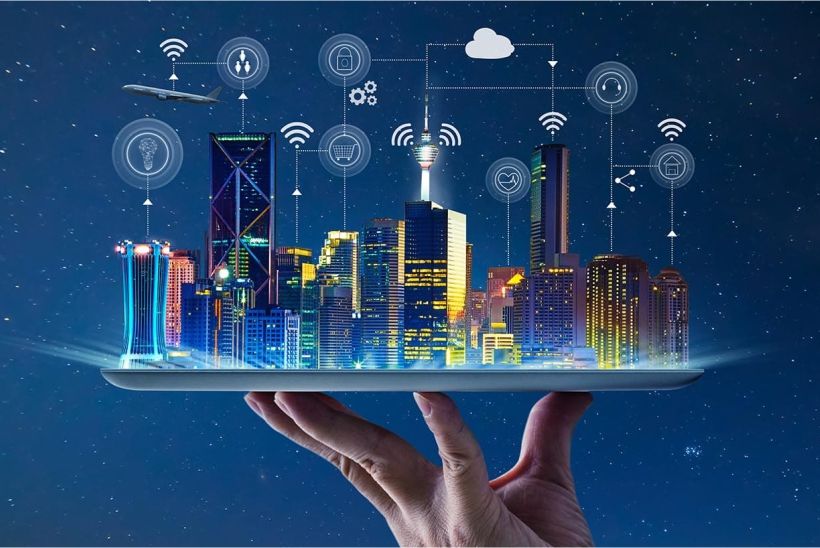What is the Internet of Things and how does it work?
The Internet of Things (IoT) refers to a network of interconnected physical devices, vehicles, appliances, and other objects embedded with sensors, software, and connectivity capabilities. These objects collect and exchange data over the internet, enabling them to communicate and interact with each other, as well as with humans.
Here’s a breakdown of how the Internet of Things works:
- Devices and Sensors: IoT devices typically consist of sensors or actuators that gather and transmit data. These sensors can detect various attributes such as temperature, humidity, motion, light, or location. The data collected by these devices can be used for monitoring, analysis, and decision-making.
- Connectivity: IoT devices are connected to the internet, allowing them to communicate with other devices, cloud-based platforms, or applications. They can use various communication technologies, including Wi-Fi, Bluetooth, cellular networks, or low-power wide-area networks (LPWANs) to establish connections and transmit data.
- Data Processing and Storage: IoT devices often generate a massive amount of data. To process this data efficiently, edge computing is employed. Edge computing involves performing data processing and analysis at or near the device itself, reducing the need for transmitting all the data to centralized servers or the cloud. This approach enables real-time or near-real-time decision-making and reduces latency.
- Cloud Infrastructure: IoT devices can also leverage cloud-based platforms for data storage, advanced analytics, and processing capabilities. Cloud platforms provide scalable and secure infrastructure for managing and analyzing the vast amount of data generated by IoT devices. They can also offer additional services like machine learning algorithms, data visualization, and remote device management.
- Applications and Services: IoT data collected from devices can be utilized by various applications and services to provide valuable insights, automation, and control. These applications can range from smart home systems and industrial automation to healthcare monitoring and smart city solutions. By analyzing IoT data, applications can trigger actions, send alerts, optimize processes, or provide personalized experiences.
- Security and Privacy: Security is a crucial aspect of IoT. As IoT devices are connected to the internet, they can be vulnerable to cyber threats. Ensuring proper security measures, such as data encryption, access controls, and firmware updates, is essential to protect IoT devices and the data they collect. Privacy concerns also arise due to the potential collection of personal or sensitive data by IoT devices, necessitating robust privacy practices and compliance with data protection regulations.

How is IoT transforming various industries?
The Internet of Things (IoT) is transforming various industries by enabling new capabilities, enhancing efficiency, and driving innovation. Here are some examples of how IoT is impacting different sectors:
- Manufacturing and Industrial IoT (IoT):
IoT is revolutionizing manufacturing processes through the Industrial Internet of Things (IIoT). Connected sensors and devices gather real-time data on machinery, production lines, and supply chains. This data enables predictive maintenance, optimizing equipment performance, reducing downtime, and improving overall operational efficiency. IIoT also enables smart factories with interconnected systems, robotics, and automation for streamlined production and enhanced productivity. - Healthcare:
IoT is revolutionizing healthcare by enabling remote patient monitoring, telemedicine, and improved patient care. Connected wearable devices and sensors can continuously monitor vital signs, collect health data, and transmit it to healthcare providers. This allows for proactive health monitoring, early detection of issues, and remote patient management. IoT also facilitates the integration of medical devices, hospital systems, and electronic health records (EHRs), streamlining workflows and improving patient outcomes. - Smart Cities:
IoT is transforming cities into smart and sustainable environments. Connected sensors and devices monitor and manage various aspects, including traffic flow, parking, waste management, energy consumption, and public safety. IoT enables data-driven decision-making, efficient resource allocation, and improved citizen services. By optimizing infrastructure and services, smart cities aim to enhance livability, sustainability, and resource utilization. - Agriculture:
IoT is revolutionizing agriculture with the concept of smart farming or precision agriculture. Connected sensors, drones, and satellite imagery provide real-time data on soil moisture, temperature, humidity, and crop health. This data helps farmers optimize irrigation, fertilization, and pest control, resulting in increased crop yields, reduced resource wastage, and improved sustainability. IoT technology also enables livestock monitoring, automated feeding systems, and asset tracking in the agricultural sector. - Transportation and Logistics:
IoT is transforming transportation and logistics by optimizing supply chain management, improving asset tracking, and enhancing operational efficiency. Connected sensors and devices monitor the condition and location of goods in transit, enabling real-time visibility and efficient route planning. IoT-enabled fleet management systems help optimize fuel consumption, reduce maintenance costs, and enhance logistics operations. Additionally, IoT technology is driving advancements in autonomous vehicles and smart transportation systems. - Energy and Utilities:
IoT is revolutionizing the energy and utilities sector by enabling smart grids, energy management, and efficient resource utilization. Connected devices and sensors monitor energy consumption, grid performance, and equipment health. This data enables real-time monitoring, demand response, and energy optimization. IoT technology also facilitates the integration of renewable energy sources, energy storage systems, and smart meters, leading to more sustainable and efficient energy management.

What are some real-world applications of IoT?
IoT has a wide range of real-world applications across various industries. Here are some examples of how IoT is applied in different contexts:
- Smart Home: IoT devices enable homeowners to automate and control various aspects of their homes. Smart thermostats regulate temperature, smart lighting systems adjust illumination, and smart security systems provide remote monitoring and control. Connected appliances, such as refrigerators and washing machines, can optimize energy consumption and provide alerts for maintenance or replenishment.
- Wearables and Healthcare: IoT wearables, such as fitness trackers and smartwatches, monitor vital signs, activity levels, and sleep patterns. They provide individuals with real-time feedback on their health and fitness goals. In healthcare, IoT devices are used for remote patient monitoring, allowing healthcare providers to track patients’ health conditions and provide timely interventions.
- Industrial Automation: IoT is utilized in industrial settings for automation and optimization. Connected sensors and devices monitor equipment health, collect data on production processes, and enable predictive maintenance. This helps reduce downtime, improve operational efficiency, and enhance worker safety.
- Smart Cities: IoT is leveraged to make cities more efficient, sustainable, and livable. Connected sensors and devices monitor and control various aspects of urban life, including traffic flow, parking, waste management, and air quality. Smart city initiatives aim to improve resource utilization, enhance public safety, and provide better services to citizens.
- Agriculture: IoT is transforming agriculture through precision farming techniques. Connected sensors collect data on soil moisture, temperature, and crop health. This information helps farmers optimize irrigation, fertilization, and pest control, resulting in increased crop yields and reduced resource wastage.
- Transportation and Logistics: IoT is used in transportation and logistics to improve efficiency and tracking. Connected devices and sensors monitor the condition and location of goods in transit, enabling real-time visibility and efficient supply chain management. IoT-based fleet management systems optimize routes, reduce fuel consumption, and enhance delivery operations.
- Energy Management: IoT is applied to energy management, enabling smart grids and efficient resource utilization. Connected devices monitor energy consumption, grid performance, and equipment health. This data helps optimize energy distribution, implement demand response programs, and increase energy efficiency.
- Environmental Monitoring: IoT devices are used for environmental monitoring and conservation efforts. Connected sensors collect data on air quality, water quality, and wildlife habitats. This information aids in environmental research, pollution control, and resource management.
